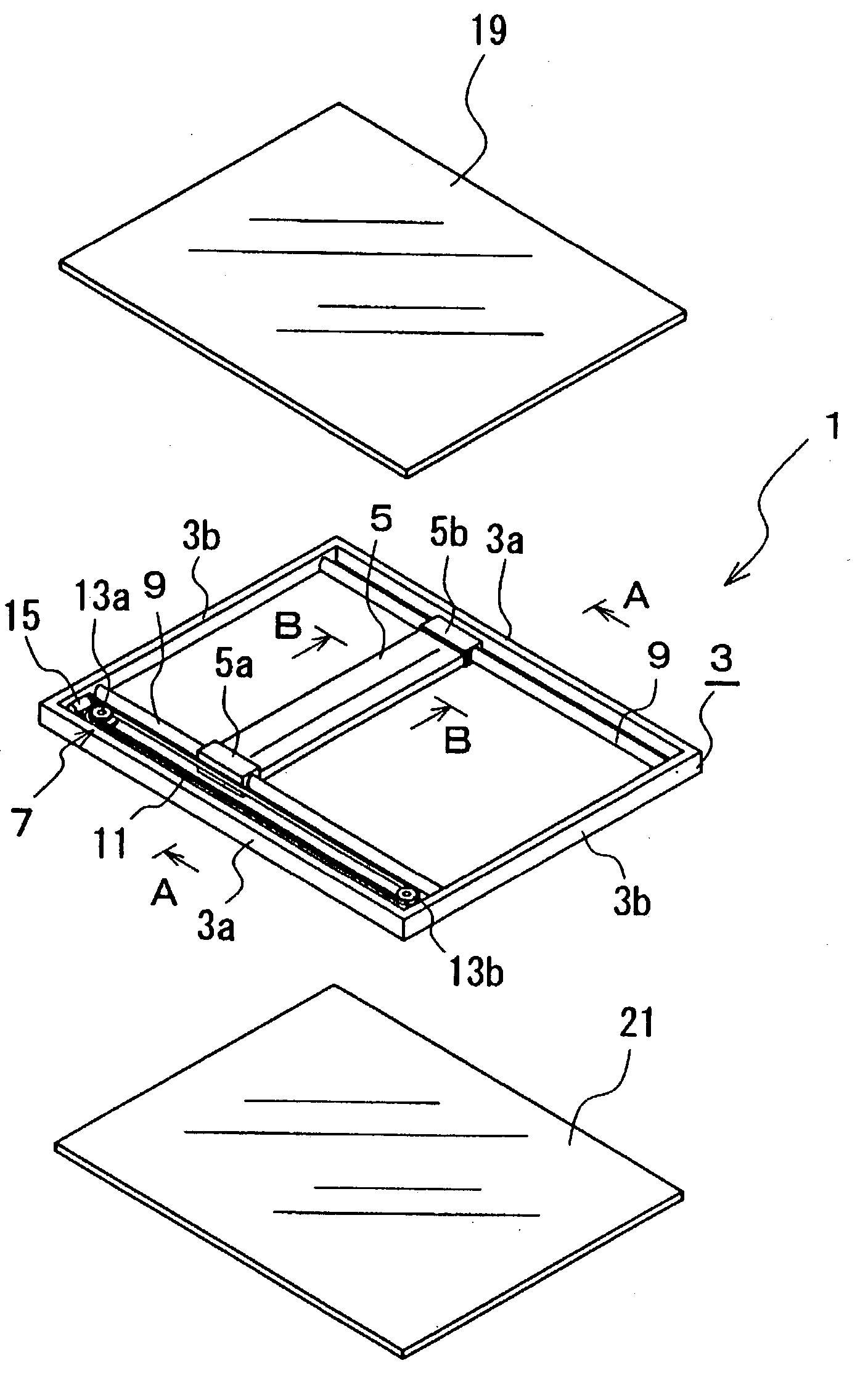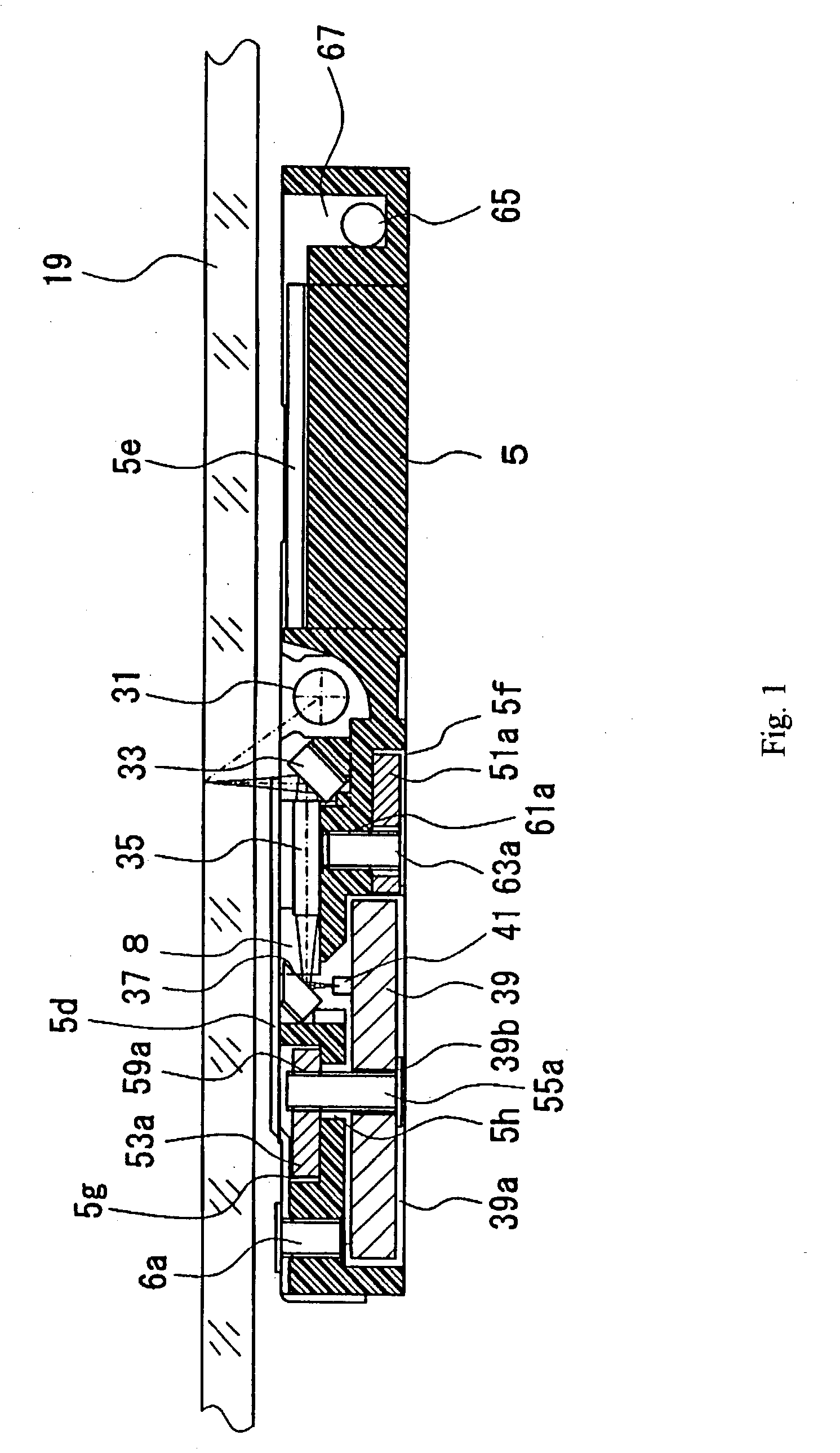Carriage structure for image-reading device
a technology of image-reading device and carriage, which is applied in the direction of electrographic process apparatus, printers, instruments, etc., can solve the problems of reducing the rigidity of affecting the accuracy of positioning of the optical elements carried by the carriage, and the image data acquired is not faithful to the document being scanned. , to achieve the effect of reducing the bowing of the carriage, increasing the rigidity of the reinforcing sheet metal, and reducing the rigidity of the rigidity of th
- Summary
- Abstract
- Description
- Claims
- Application Information
AI Technical Summary
Benefits of technology
Problems solved by technology
Method used
Image
Examples
first embodiment
[0025]With the carriage structure the rigidity of the carriage 5 is increased because the reinforcing sheet metal members 51a and 53a are incorporated into the carriage 5. Through this, bowing of the carriage 5 is prevented even when the device is made thinner. In particular, because the first reinforcing sheet metal member 51a is positioned below the rod lens array 35 that guides the light reflected from the original document to the photoelectric conversion device 41, bowing of the rod lens array 35 is prevented, and changing of the optical path length from the original document surface to the photoelectric conversion device 41 between the edges and the center of the carriage 5 is prevented. In other words, because the rod lens array 35 is composed of column-shaped rod lenses arranged in parallel, bowing can readily occur between adjacent rod lenses, but by using the first reinforcing sheet metal member 51a, bowing can be prevented.
second embodiment
[0026]The carriage structure shown in FIG. 2 will be explained next. Parts that are the same as in the embodiment shown in FIG. 1 are labeled with the same reference numbers. As shown in FIG. 2, the second reinforcing sheet metal member 53b is bent so as to have a substantially L-shaped cross-section, and the leg 54a on the longer side thereof is seated in second indentation 5i. The second indentation 5i is linked to the unit holder 8a in which is seated the optical unit that includes the second reflective mirror 37a, and the leg 54b on the short side of the L-shaped second reinforcing sheet metal member 53b is positioned inside the unit holder 8a, the tip thereof pointing downward.
[0027]In addition, the first reinforcing sheet metal member 51b is formed with the cross-section substantially crank-shaped, as shown in FIG. 2, and is positioned on the bottom surface of the unit holder 8a. The bottom surface of the unit holder 8a has a step formed to coincide with the substantially cra...
third embodiment
[0033]With the carriage structure the first reinforcing sheet metal member 51c and the second reinforcing sheet metal member 53c are both bent in the center in the width-wise direction. Because the reinforcing sheet metal members 51c and 53c can resist a larger bending moment than the reinforcing sheet metal members 51a and 53a formed in a strip shape, it is possible to maintain the flatness of the carriage with greater certainty.
[0034]In addition, in the carriage structure according to the third embodiment, the first reflective mirror 33c is attached to the first reinforcing sheet metal member 51c and the second reflective mirror 37c is attached to the second reinforcing sheet metal member 53c. Therefore, it is possible to attach the reinforcing sheet metal members 51c and 53c to the carriage 5 with the reflective mirrors 33c and 37c being pre-attached. In particular, in making the carriage 5 thinner and lighter in weight, the reflective mirrors 33c and 37c are made to be extremel...
PUM
 Login to View More
Login to View More Abstract
Description
Claims
Application Information
 Login to View More
Login to View More - R&D
- Intellectual Property
- Life Sciences
- Materials
- Tech Scout
- Unparalleled Data Quality
- Higher Quality Content
- 60% Fewer Hallucinations
Browse by: Latest US Patents, China's latest patents, Technical Efficacy Thesaurus, Application Domain, Technology Topic, Popular Technical Reports.
© 2025 PatSnap. All rights reserved.Legal|Privacy policy|Modern Slavery Act Transparency Statement|Sitemap|About US| Contact US: help@patsnap.com



